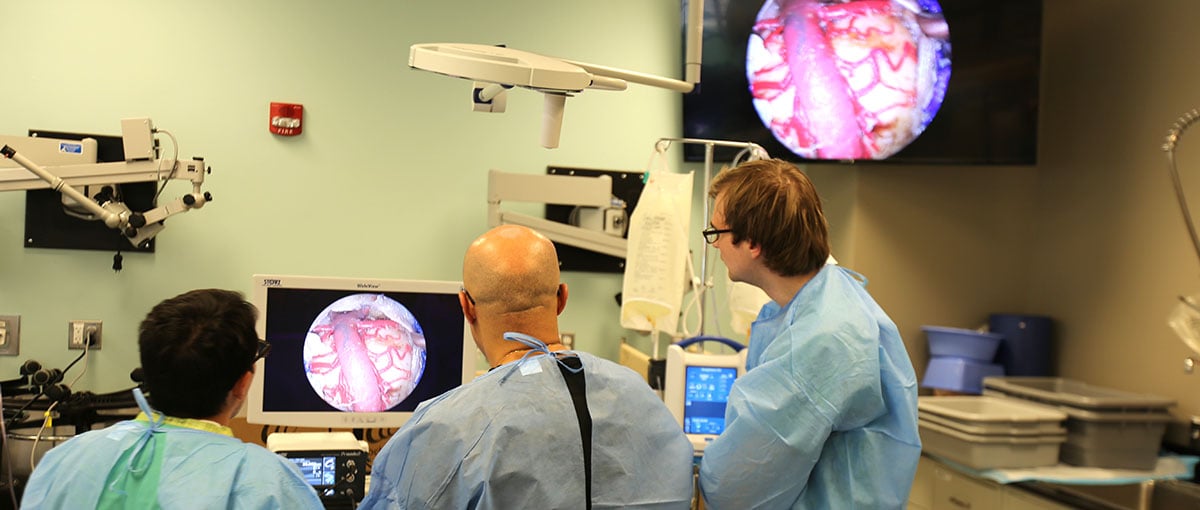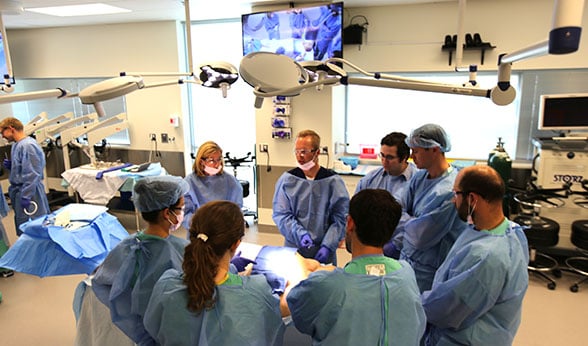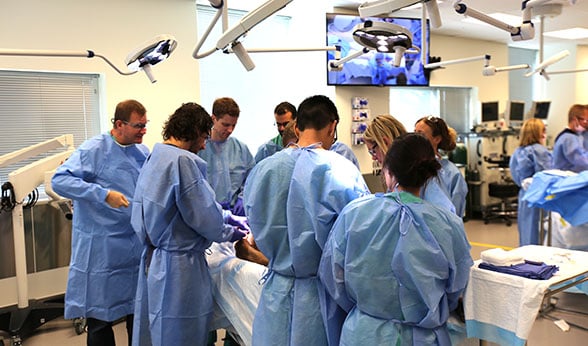 Samy Youssef, MD, PhD, professor of neurosurgery in the CU School of Medicine, (center) demonstrates a minimally invasive brain surgery procedure for two visiting neurosurgeons using live imaging technology in the Center for Surgical Innovation.
Samy Youssef, MD, PhD, professor of neurosurgery in the CU School of Medicine, (center) demonstrates a minimally invasive brain surgery procedure for two visiting neurosurgeons using live imaging technology in the Center for Surgical Innovation.
Efficiency in health care is a subject that gets a lot of attention these days. A combination of efficiency and positive outcomes sums up the astonishing amount of activity that takes place at the Center for Surgical Innovation (CSI) on the University of Colorado Anschutz Medical Campus.
Considering that CSI offered 263 training sessions to surgeons from around the world in fiscal 2016 – up 65 percent from 2015 – it’s safe to say that the facility’s innovations and education programs are rapidly improving health care across the globe.
CSI typically offers four to five trainings a week. It’s not unusual for surgical courses on skull base tumors to take place one day, aortic aneurysms the next and hernia repair the next. Partitions are often set up so different trainings – a spinal surgery here, a heart procedure there – can take place simultaneously. Surgical techniques on every quadrant of the body are taught in the facility by world-class experts from the CU School of Medicine (SOM) using state-of-the-art equipment.
‘Our mission is to educate’
“We try to be a one-stop shop for everyone who trains here. We handle logistics on everything from lodging and transportation to the specimen and equipment needs of each training,” said Sarah Massena, CSI executive director. “We just try to make it streamlined and easy for the trainees who come here, so they can go back home and enhance patient safety.
“Our main mission is to educate,” she said, “We want to enhance patient safety in the operating room.”
 Hundreds of surgical training sessions, such as this one, take place each year at the Center for Surgical Innovation at the CU Anschutz Medical Campus.
Hundreds of surgical training sessions, such as this one, take place each year at the Center for Surgical Innovation at the CU Anschutz Medical Campus.
CSI, which operates 24/7 and is the only surgical training center at an academic institution in this region, moved to a new space inside Bioscience 1 in the Fitzsimons Redevelopment Authority (FRA) in early 2015 and has seen a dramatic increase in trainings since. Last year, 3,400 surgeons attended trainings in the 5,000-square-foot facility.
The high-volume facility, which launched in 2005, was previously located in a 1,700-square-foot space in the anatomy lab on the fifth floor of the Education 1 building.
“One of the major advantages of this facility is that it’s a custom build-out,” said Peter Mouser, CSI lab manager. “These suites were an empty shell, and we worked with our architects and building-design people to have the surgical training suite be built out the way it should be.”
Attractive to medical device industry
A challenge, however, is that the CSI loses the rent discount that came with being physically located on an academic medical campus. Being across the street – the FRA is located on the north side of Montview Boulevard – means that CSI’s rent increased. “We had to move here because, for our needs, it was the only space available,” Massena said. “We’re still right next door to an academic medical campus, so our trainees can drive in, park for free and come straight into our lab.” For physicians already on campus, including residents at the University of Colorado Hospital (UCH), CSI is an easy walk from the hospital.
The facility is multidisciplinary, so it has five founding surgical departments in the SOM that help fund its operations. The departments, representing 15 surgical divisions, are Surgery, Orthopedics, Obstetrics and Gynecology, Otolaryngology and Neurology. The many “outside” trainings offered by CSI – 70 percent of the courses are for surgeons from outside the CU Anschutz Medical Campus, compared to 30 percent for residents at the campus – help subsidize the departmental-member trainings.
 Medical residents from the University of Colorado Hospital Emergency Department receive surgical training on a cadaver at a recent CSI educational program.
Medical residents from the University of Colorado Hospital Emergency Department receive surgical training on a cadaver at a recent CSI educational program.
CSI is attractive to industry representatives seeking to test medical technology. Medtronic, an international medical device company, collaborates with Omid Jazaeri, MD, an associate professor in the Department of Surgery, on its latest stent technology. Da Vinci Surgery regularly brings in its magnified, 3D high-definition vision technology for trainings. The state-of-the-art robotics system allows surgeons to operate with enhanced vision and precision. The system also allows a surgeon at another location, such as on the East Coast, to operate a remote console and perform procedures in CSI’s surgical suite.
CSI is expanding into bioengineering research and development as well as nursing programs and unique trainings that educate surgeons on how to perform procedures in low-resource environments without high-tech surgical tools.
‘Impressed by this facility’
Each spring, Samy Youssef, MD, PhD, professor of neurosurgery in the CU SOM, has trained over 60 surgeons from around the globe at a three-day cadaveric dissection-training course in skull base/endoscopic surgical techniques. The invitational course is in high demand and currently filled through the 2020 session.
“The surgeons we have coming from Germany, Japan and elsewhere are impressed when they see this facility,” Youssef said. “For example, it’s very convenient to have the lecture room next door to the surgical room where the senior residents get hands-on practice.”
In addition, CU’s Department of Neurosurgery offers a Skull Base Surgery year-long fellowship/resident program that uses the CSI Microsurgery Laboratory to give young neurosurgeons exposure to complex cranial cases and minimally invasive skull base approaches.
Besides the cadavers on the operating tables and the surgeons in scrubs surrounding them, the striking elements of CSI are the innovative pieces of equipment, flat-screen monitors all around, and the booms that house the equipment. Less obvious are ceiling cameras that can zoom in on proctor stations and livestream procedures across the globe. Procedures are also regularly recorded.
Robust AV technology
Trainees can watch a live feed of a surgery taking place at UCH and simultaneously practice the techniques on specimens at CSI. “The audio-visual (AV) technology is very robust in this facility,” Mouser said. “It really provides for an enhanced educational experience for our surgical trainees.”
The facility is so busy that it is already bursting at the seams to store its surgical equipment. Staffing is another area that had to be increased to deal with demand. CSI recently hired two lab support technicians to help stagger the hours of the small staff – the facility now has five employees, including Medical Director Thomas Robinson, MD – around the late-day, early-morning and weekend training sessions that best suit surgeons’ busy schedules.
The staff at CSI constantly has dialogues with surgeons about the latest techniques and equipment on which they’d like to have training. “Also,” Massena said, “we engage in a lot of continuing medical education for surgeons to learn the latest surgical techniques.
“What I always say is, ‘Wouldn’t you rather that your surgeon practices techniques in a lab than on your mother, father, brother or sister in the OR?’” she said.
